精准定位低环境效率作物,有利于有针对性地调控多样化农业环境足迹
IF 9.8
1区 社会学
Q1 ENVIRONMENTAL STUDIES
引用次数: 0
摘要
农作物生产在养活人类的同时也给环境带来了各种负担。针对区域关键作物进行有效的环境足迹调控仍然难以解决,特别是当作物的指标扩展和局部环境效率尚不清楚时。本研究通过追踪8组活动对15种作物的12种生命周期环境影响,在中国省际尺度上评估作物足迹的大小和多维效率(以作物产量、播种面积和经济价值衡量),确定区域关键作物,提取多样性环境足迹的潜在调控路径。介绍了每个地区的活动、作物、影响和效率之间的完整定量联系。以作物产量衡量,甘蔗、甜菜和蔬菜总是表现出更高的效率。以播种面积衡量,大豆在所有影响类别中表现出最高的效率。经济作物(如烟草和茶叶)和花生在衡量经济价值时通常更环保。在三次测量中,由于甲烷排放,水稻在气候变化中的效率一直较低。农药投入大的水果在生态毒性相关影响方面效率较低。综合考虑低效率和高足迹贡献,水果被确定为气候变化和臭氧消耗的关键作物,主要在西北和西南地区。小麦和玉米是气候变化和光化学氧化剂形成的关键作物,主要在北方。以提高关键作物的效率为目标,可能产生与改善所有低效作物相当的缓解结果,两种情景之间的差异小于3.5%。提取的调控路径涵盖了明确的影响-区域-作物-活动对应关系,从而为作物生产提供更精确和更具成本效益的环境足迹控制。本文章由计算机程序翻译,如有差异,请以英文原文为准。

Pinpointing low environmental efficiency crops boosts pertinently regulating diversified agricultural environmental footprints
Crop production imposes various environmental burdens when feeding humanity. Targeting regional critical crops for effective environmental footprints regulation remains intractable especially when indicator-extended and localized environmental efficiencies of crops are unclear. This study pinpoints regional critical crops and extract potential regulation paths for diversified environmental footprints by tracing 12 types of life cycle environmental impacts of 15 crop species inflicted by 8 groups of activities, and evaluating magnitudes and multidimensional efficiencies (measured by crop yield, sown area, and economic value) of crops' footprints at the provincial scale in China. The complete quantitative links among activities, crops, impacts, and efficiencies in each region are presented. Sugarcane, sugar beet, and vegetables always demonstrate higher efficiencies measured by crop yield. Soybean shows the greatest efficiencies measured by sown area in all impact categories. Cash crops (such as tobacco and tea) and peanut are regularly more environmentally efficient when the measure shifts to economic value. For three measurements, rice consistently shows lower efficiency in Climate change due to methane emission. Fruits, with heavy pesticide input, have lower efficiencies in the ecotoxicity-related impacts. When both low efficiency and high contribution to footprints are integrated, fruits are identified as critical crops, primarily in the northwest and southwest, for Climate change and Ozone depletion. Wheat and maize are critical crops, mainly in the north, for Climate change and Photochemical oxidant formation. Targeting efficiency improvements in critical crops may yield mitigation outcomes comparable to those from improving all inefficient crops, with differences of less than 3.5% observed between the two scenarios. The extracted regulation paths covering explicit impact-region-crop-activity correspondence yield insights into more precise and cost-effective environmental footprints control for crop production.
求助全文
通过发布文献求助,成功后即可免费获取论文全文。
去求助
来源期刊

Environmental Impact Assessment Review
ENVIRONMENTAL STUDIES-
CiteScore
12.60
自引率
10.10%
发文量
200
审稿时长
33 days
期刊介绍:
Environmental Impact Assessment Review is an interdisciplinary journal that serves a global audience of practitioners, policymakers, and academics involved in assessing the environmental impact of policies, projects, processes, and products. The journal focuses on innovative theory and practice in environmental impact assessment (EIA). Papers are expected to present innovative ideas, be topical, and coherent. The journal emphasizes concepts, methods, techniques, approaches, and systems related to EIA theory and practice.
 求助内容:
求助内容: 应助结果提醒方式:
应助结果提醒方式:


